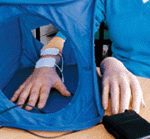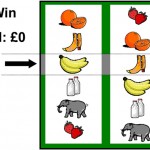 Researchers in the United Kingdom are trying to help amputees speed up the process of getting used to prostheses by harnessing a well-known illusion.
Researchers in the United Kingdom are trying to help amputees speed up the process of getting used to prostheses by harnessing a well-known illusion.
In the “rubber hand” illusion, a person’s hand and an adjacent rubber hand are both brushed gently. The real hand is kept out of sight. Before long, the subject’s brain creates a new spatial link, imagining that the sensation in the real hand is arising where the rubber hand is.
Graduate student Matthew Mulvey of Leeds Metropolitan University has now shown that the effect will work if the researchers deliver transcutaneous electrical nerve stimulation (TENS) not to the hidden hand but to the wrist. After being primed with the illusion, subjects perceive the impulses–which hijack the nerve pathways between hand and brain–as a tingling located in the rubber hand. The researchers predict that with an amputee, a TENS signal from above the site of amputation would seem to come from the fake limb.
The team, which showed its results at the Royal Society’s Summer Science Exhibition last week, hopes TENS can help amputees adapt faster to prostheses and possibly counter phantom limb pain, a major problem. Kate MacIver, a research nurse at the Pain Research Institute at the University of Liverpool in the U.K., says the idea is “harmless, … so it’s worth a try.”
Originally appeared in Science Magazine as a Random Sample: [html] [pdf]
 Before the reels on a slot machine stop spinning, a gambler’s brain is already anticipating the potential rewards. And although two bananas on the pay line with a third just barely visible won’t pay a gambler any more than three random fruits, such near misses have the well-documented, if irrational, effect of enticing gamblers to try again. The reason, according to a new study, is that these near misses activate the same reward signals in the brain as a win.
Before the reels on a slot machine stop spinning, a gambler’s brain is already anticipating the potential rewards. And although two bananas on the pay line with a third just barely visible won’t pay a gambler any more than three random fruits, such near misses have the well-documented, if irrational, effect of enticing gamblers to try again. The reason, according to a new study, is that these near misses activate the same reward signals in the brain as a win.

